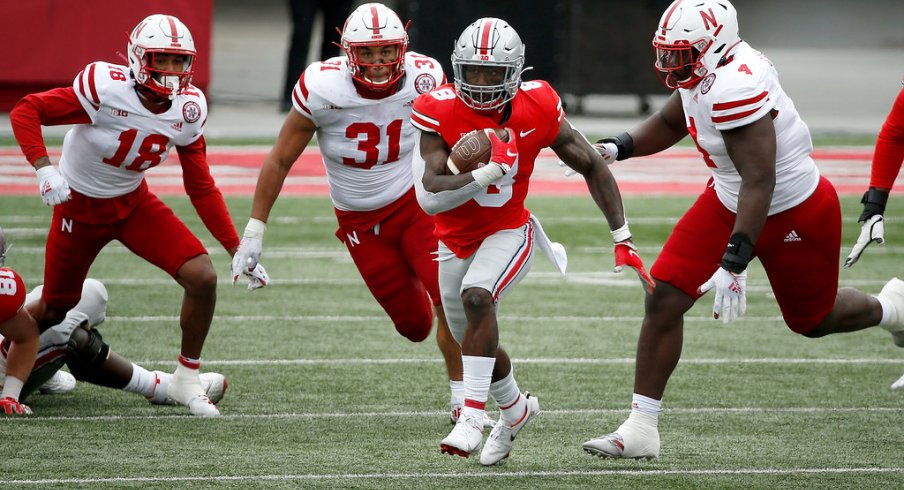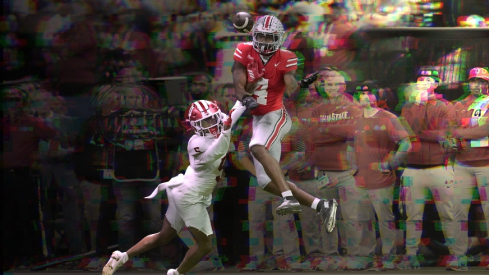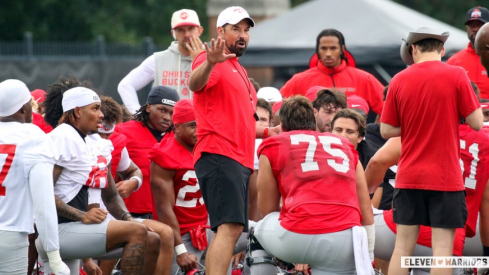After ten long months, we're finally back.
No, I'm not referring to the analysis of real, live Ohio State football games. I'm referring to panic that ensues within the fanbase following a 35-point victory over a conference opponent.
While Justin Fields' near-perfect day made national headlines, many of the Buckeye faithful have chosen instead to hone in on the moments in which the local team looked merely mortal. Fixating on such blemishes is part of the business of supporting a national championship contender in the bizarrely wonderful sport that is college football, but we here at Film Study encourage everyone to pause, take a deep breath, and step away from the ledge.
The Buckeye running game will be fine.
Why might we feel this way following a performance in which the scarlet and gray rushed for only 222 yards? Let's take a deeper look:
Looking like the Blackshirts
As the Buckeyes took the field for the first time in 2020, Justin Fields spent much of the opening possession showing his Heisman credentials, completing three passes for 52 yards and moving the ball efficiently downfield. On that same drive, however, Master Teague III carried the ball five times while picking up just six yards.
Once inside the red zone, that ineffectiveness was most apparent, as Teague was stuffed on a Mid-Zone Slice play that was a hallmark of the OSU run game last year.

Upon further review, however, it is clear that Nebraska was selling out to stop the run. Not only did the Cornhuskers line up with eight defenders in the box - giving them an advantage against Ohio State's six blockers and the QB - but the inside linebackers were blitzing on early downs.
With no noise inside the stadium, it was much easier for those additional rushers to time up the snap count, as #3 Will Honas does in the example above, beating Wyatt Davis and plugging the A-gap. That disruptive, downhill play from Nebraska's inside linebackers continued throughout the first half, even when not sending pressure.
On another Mid-Zone run with Teague, center Josh Myers isn't able to work up to #31 Collin Miller after chipping the nose tackle, allowing the linebacker to quickly fill the A-gap and leave Teague with nowhere to go.
As noted by Joel Klatt on the broadcast, the Huskers did a good job of forcing Fields to keep on a number of early option plays, though it was only a handful. Given the importance of avoiding an injury to Fields, Ryan Day and his staff began running designed handoffs with the QB feigning a read.
Yet the visitors remained on the attack. On a 3rd-and-1 inside the red zone, the Buckeyes hurried to the line in hopes of catching the defense by surprise. But as Fields gave the ball to Trey Sermon on an inside Power run behind a pulling guard, outside linebacker Jojo Domann (#13) darted into the backfield on a blitz, stuffing the play for no gain.
Had Fields been reading a player, it wouldn't have been Domann, it would've been the defensive end (#44 Garrett Nelson), who was blocked by the tight end, Luke Farrell. The Buckeyes simply never expected Domann to blitz off the edge.
“I think that happens sometimes when you're used to going against a certain front for months at a time and seeing the same looks and the same fronts,” Day said after the game. “Nebraska brings a bunch of different stuff. It was a little bit of a different fit. I thought we did fit some runs good there."
Unforced Errors
Not every unsuccessful run was due to the Nebraska game plan, though.
Fields decided to keep the ball on a Bash (Back-Away Sweep) play during the opening possession. Despite having numbers on the left, the QB elected to dart up through the right side, taking a number of unneeded hits along the way.
While the unblocked defender did rush upfield, giving Fields a keep read, it was a defensive tackle who was unlikely to catch the running back going on a flat, fast path to the edge. Much has been made about Fields' participation in the run game, though those fears may be overblown.
By our count, Fields only kept the ball on three options plays and pushed forward on two QB sneaks. The other ten carries he registered against the Huskers came on scrambles as he chose to tuck and run instead of throw. These decisions resulted in a number of big plays, including his third-quarter touchdown run, but the three sacks surrendered as well.
Fields wasn't the only Buckeye who was imperfect in the run game. On multiple early occasions, the interior trio of Myers, Harry Miller, and Wyatt Davis struggled to handle combination blocks on zone runs, leaving defenders unblocked and in position to make plays.
Similarly, Teague and Sermon made some questionable decisions with the ball in their hands.
As we can see example above, Myers does a great job of getting across the face of the nose tackle while Davis gets up to the linebacker, creating a huge hole in the frontside A-gap. Yet instead of banging through that crease, Sermon decides to cut back into a far tighter lane and is stuffed short of the first down.
"I really do believe that once we get rolling, our running game will be back to even better than what it was last year," Davis told reporters over video-conference following the game. "I just think that we've just got to knock off the rust of not playing against another team and just really focus this week on film and what we did wrong and how we can get better. Really focusing on the little things.”
In-Game Adjustments
While the Buckeyes' All-American guard is correct to say his team will improve after watching the film, the process started in the second quarter.
With just five minutes remaining in the half, the Buckeyes discovered a seam in the Huskers' plan. By lining up every eligible player to one side, the defense was outmanned in the opposite direction, allowing Sermon to pick up solid yardage on a Mid-Zone Slice play through the B-gap.
After halftime, Day and his staff went back to this concept on multiple occasions, allowing Sermon to break off a handful of solid runs including this 18-yarder going the opposite direction, the longest of any Buckeye back all day.
Teague also benefited from this concept, converting a 3rd-and-4 with a seven-yard carry in the fourth quarter.
After a few shaky drives at the beginning, the Buckeye O-line had clearly gotten more comfortable, pounding the ball in for a statement touchdown from Teague just before the half. Myers sealed the slanting defensive tackle (#99) inside while Miller drove the other tackle completely out of the play, giving Teague a clear lane toward the end zone.
“I thought the offensive line still played really well,” Day said. “I thought they knocked people off the ball. And there were still some good runs in there. But we'll improve and we'll get better from this.
With the Husker defense so focused on stopping the run throughout the afternoon, Fields was happy to move the ball through the air. The Buckeyes utilized a variety of downfield and bootleg passes off play-action, seeming to find open receivers at will.
Additionally, Day began tagging inside runs with quick hitches to the outside, giving his QB the chance to pull the ball and throw instead. With eight players keeping their eyes in the backfield, the corners played a very soft cushion outside on Chris Olave and Garrett Wilson, providing Fields with easy targets.
Though there were no big, game-breaking home plays on the ground, the OSU running game was far more effective in the second half, averaging 5.5 yards-per-carry. Questions will linger about the ability of Teague or Sermon to break long runs, but that may not be their role in this system.
As seen on Saturday, this offense will create explosive plays through the air thanks to a gifted corps of wide receivers and the most talented passer in school history. The run game will certainly be important, but it won't be looked at as the engine it often was during the [insert any previous Ohio State coach] era.
This fundamental change will likely feel uncomfortable to most Ohioans. But a team only needs a good ground game when it has an outstanding aerial attack in its arsenal.
Thanks to an effortless, yet phenomenal effort that from that passing game, Nebraska's aggressive plan to slow the Buckeye rushing attack proved meaningless. The home team still tallied nearly 500 yards of offense and cruised to a conference win.
If we could accurately predict the future, we here at Film Study would be in another line of work. But something tells us that future opponents might be a little more worried about Justin Fields' arm moving forward, which will make the legs of Master Teague III and Trey Sermon look a whole lot more effective down the road.



